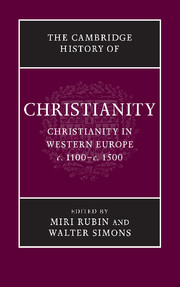Book contents
- Frontmatter
- Introduction
- PART I INSTITUTIONS AND CHANGE: 1100–1200
- PART II FORGING A CHRISTIAN WORLD, 1200–1300
- 5 The theological framework
- 6 The legal underpinnings
- 7 Material support I: parishes
- 8 Material support II: religious orders
- 9 The Word and its diffusion
- PART III THE ERECTION OF BOUNDARIES
- PART IV SHAPES OF A CHRISTIAN WORLD
- PART V CHRISTIAN LIFE IN MOVEMENT
- PART VI THE CHALLENGES TO A CHRISTIAN SOCIETY
- PART VII REFORM AND RENEWAL
- Select bibliography
- Index
- Map 1 Western Europe c. 1100 – c. 1500
- Map 2 Universities of Europe
6 - The legal underpinnings
from PART II - FORGING A CHRISTIAN WORLD, 1200–1300
Published online by Cambridge University Press: 28 March 2010
- Frontmatter
- Introduction
- PART I INSTITUTIONS AND CHANGE: 1100–1200
- PART II FORGING A CHRISTIAN WORLD, 1200–1300
- 5 The theological framework
- 6 The legal underpinnings
- 7 Material support I: parishes
- 8 Material support II: religious orders
- 9 The Word and its diffusion
- PART III THE ERECTION OF BOUNDARIES
- PART IV SHAPES OF A CHRISTIAN WORLD
- PART V CHRISTIAN LIFE IN MOVEMENT
- PART VI THE CHALLENGES TO A CHRISTIAN SOCIETY
- PART VII REFORM AND RENEWAL
- Select bibliography
- Index
- Map 1 Western Europe c. 1100 – c. 1500
- Map 2 Universities of Europe
Summary
The legal underpinnings of the Western church experienced a major transformation during the twelfth and thirteenth centuries. This was a period in which papal legislation found its stride, in the form of conciliar decrees and papal decisions. Papal jurisdiction was much expanded and produced a rich body of case law which became systematically collected. The law of the church, ‘canon law’, became a subject of study in the emerging universities of Europe, which produced an expanding and often innovative body of commentary and analysis. As a result, canon law moved towards greater complexity, sophistication and precision. The reasons for this development are to be found in general developments within European government and administration as well as in the history of the high medieval church. The movement to reform the church, which is usually thought to have begun with the German Emperor Henry III’s intervention in the affairs of the papacy in 1046, propagated a vision of the church that was firmly rooted in law. The reformers also used law in impressing that vision on clergy and laity. These circumstances gave impulses to both the study of law and renewed vigour in ecclesiastical legislation.
Great efforts to trawl libraries and archives for law and to collect it in useful formats characterised the first century after 1046. Among the discoveries were many canon and Roman law texts, including Justinian’s Digest. Many authors compiled collections of church law along lines that furthered the goals of the papal reform movement. Notable is the collection (c. 1083) of Bishop Anselm of Lucca, who was a close associate of Pope Gregory VII (1073–85). His work with its insistence on the power and supremacy of the papacy bears out that pope’s programme. Anselm was the first canonist to bring a systematic effort to collecting the law concerning just war, a topic of immediate relevance in a time of open war between the German emperor and the papacy, and on the cusp of the crusades.
Keywords
- Type
- Chapter
- Information
- The Cambridge History of Christianity , pp. 89 - 98Publisher: Cambridge University PressPrint publication year: 2009



